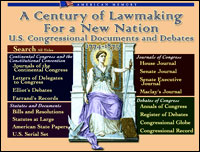Jefferson Scholarship
Bill Barker, an interpreter at Colonial Williamsburg, talks about Thomas Jefferson, the historical figure he portrays. Barker focuses on Jefferson's beliefs and ideals as reflected in the Declaration of Independence.
Bill Barker, an interpreter at Colonial Williamsburg, talks about Thomas Jefferson, the historical figure he portrays. Barker focuses on Jefferson's beliefs and ideals as reflected in the Declaration of Independence.
Ken Johnston, a historical interpreter at Colonial Williamsburg, looks at the beliefs and actions of Benedict Arnold, arguing that Arnold never betrayed his own beliefs and values.
Ken Johnston, an interpreter at Colonial Williamsburg, portrays Benedict Arnold, the American general and hero of Saratoga who became a British brigadier general and fought in the Revolutionary War on the British side. Johnston gives the general's perspective in 1781, after he captured Richmond and Williamsburg.

This comprehensive set of Congressional documents covers the nation's founding through early Reconstruction. Materials are organized into four categories: Continental Congress and the Constitutional Convention; Statutes and Documents; Journals of Congress; and Debates of Congress. The site provides descriptions of 16 types of documents, including bills and resolutions, American State Papers, the U.S. Serial Set, Journals of the Continental Congress, the Congressional Globe, and the Congressional Record.
A presentation addresses the making of the Constitution that introduced an 1834 compilation of Congressional debates and proceedings and a timeline presents American history as seen in Congressional documents. Special attention is directed to Revolutionary diplomatic correspondence, Indian land cessions, the Louisiana Purchase, the Journal of the Congress of the Confederate States of America, 18611865, the impeachment of Andrew Johnson, and the electoral college.
The Historic Fort Stueben is a reproduction fort built upon the site of the original. Dating to 1786, the original fort was built by the First American Regiment for the purpose of protecting surveyors from local Native American groups. Their safety thus bolstered, the surveyors were able to map the Northwest Territory (1789-1803), as requested by the Continental Congress. The site includes the First Federal Land Office (an original structure), officers' quarters, enlisted quarters, a quartermaster's office, artificer shop, hospital, and commissary. Topics covered include early Ohio history and the voyage of Lewis and Clarke (1803-1806).
The fort offers tours and demonstrations of surveying, blacksmithing, and flintknapping.
This iCue Mini-Documentary describes the selection of the commanding general needed to lead the new Continental Army. John Adams convinced the Second Continental Congress to elect George Washington as the commander-in-chief.
This feature is no longer available.
This iCue Mini-Documentary describes the continuation of the American Revolution for another two years following the defeat of the British at Yorktown in 1781.
This feature is no longer available.